HOW TO BUILD A HOME SAUNA
Step 1: Plan the Installation
When setting up a home sauna, location is important. You can place a sauna on concrete, tile, linoleum or any surface that does not absorb moisture. Do not install a sauna over carpeting.
Custom sauna kits are fabricated to your specifications – you draw up a plan and the manufacturer cuts and supplies all the materials for the sauna enclosure. Kits typically do not include framing lumber, insulation and wiring, which you (or your contractor) provide.
The manufacturer also supplies plans that you use to construct a base and enclosure for the kit.
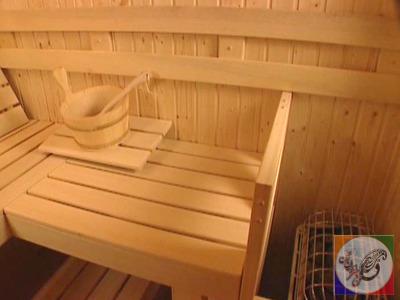
ساخت سونا
Step 2: Frame the Sauna Walls
Following the plans, measure and mark rough dimensions for the wall base plate. Snap chalk lines to outline the floor framing location.
The walls are built in three sections. Lay out the triangular base plate using 2×4 pressure treated wood, which is recommended for contact with concrete to avoid moisture problems (Image 1).
Cut two additional 2×4 top plates to match the bottom plate. Overlap the joints on the top plates. Mark wall stud locations at the same time on both top and bottom plates.
Cut the required number of studs to the height specified in the plans. Your kit will fit within the room dimensions you provided, including the ceiling height. Saunas are designed as small enclosures to conserve heat. The optimum ceiling height for a home sauna is 84” or less; the distance from the sauna’s bench seat to the interior ceiling is typically about 42 inches.
Once all the pieces are cut and marked according to the drawings, lay them out in their proper position, then use 10d galvanized common nails, or a pneumatic nail gun, to fasten the studs and plates together (Image 2). Fasten the studs to just one of the top plates and set the other top plate aside.
If you are installing against unfinished, open-stud walls, as shown here, and your sauna framing does not intersect with an existing stud, add 2×4 blocking between the nearest studs to provide a solid nailing base for the sauna’s end-wall stud.
If your sauna framing intersects with a finished (drywall covered) wall, attach a 1×6 backer board to the wall using drywall anchors spaced vertically about two feet apart. This will serve as a nailer for the end stud.
Install unfaced insulation in the walls directly behind the sauna location.
Hang temporary polyurethane sheeting, shown here stapled over the insulation, to create a less hazardous, and more comfortable, working environment while the framing is completed. A permanent foil vapor barrier will be applied later when the kit walls are installed.
Apply construction adhesive to the bottom of the base plate. Adhesive provides stability and seals the base plate to the floor, but some type of mechanical fastening is also recommended. To attach framing lumber to concrete, use concrete nails driven with a hand sledge, or drill and drive concrete-tapping screws, or rent a powder-actuated nailer (Image 3).
Stand the first wall in place, check to make sure it is level, then use 3” drywall screws to attach the end stud to the 1×6 nailer. Pre-drill the screw holes to make this job easier.
Frame a rough opening for the door according to the dimensions specified in the plans.
Nail the second top plate to the top of the wall. This will tie the three wall sections together and give the structure additional strength.
Add 2×4 blocking between the studs to strengthen the frame.

ساخت سونا
Step 3: Frame the Sauna Roof
Attach a 2×4 ledger board across the back of the sauna’s interior wall, as shown in the plans, to support the ends of the ceiling joists (Image 1).
Lay out the 2×4 ceiling joists 16″ on center, across the top. Include framing to provide a 6″ overhang on both sides. Allow for a front overhang of about 10” (Image 2). Refer to the plans for specific dimensions.
Cut off the rafter ends to create a front soffit over the doorway. Measure the shortest rafter to determine the length of the overhang.
Install 2×4 fascia framing using 16d common nails.
-
-

ساخت سونا
Image 1
-

ساخت سونا
Image 2
-
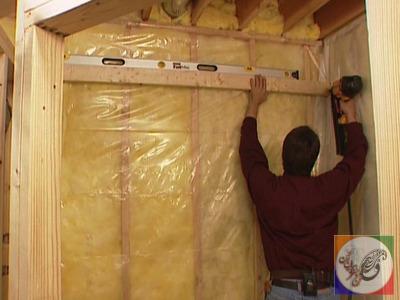
ساخت سونا
Step 4: Complete the Enclosure
Complete the enclosure by framing the windows, if provided in the kit.
Run the wiring for the sauna heater, interior lighting and light switch. The sauna heater calls for 220 volt electrical service, which requires professional installation and code inspection.
The basic construction is now finished and the enclosure is ready for the kit components to be installed.
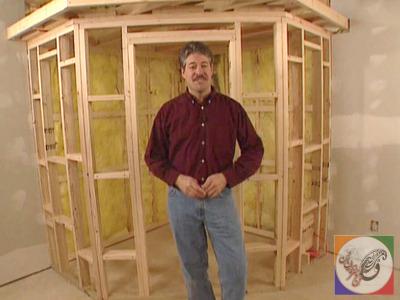
Sauna Modern Home Design
Step 5: Install the Foil Vapor Barrier
Unfaced insulation is specified for the sauna’s interior walls because a special foil vapor barrier is supplied with the kit – if your insulation already has a vapor barrier it must be removed.
Staple the foil to the wall studs, starting at the bottom. Overlap all seams 5″ and extend the vapor barrier up over the ceiling joists, completely covering the interior. The foil serves as both a vapor barrier and a heat reflecting material.

Sauna Modern Home Design
Step 6: Install the Interior Cladding
Start by installing the sauna’s kit’s tongue-and-groove ceiling boards. The boards are pre-cut to length, but some trimming to fit may be required, particularly at angles.
Place the first board’s tongue edge against the wall and nail through the tongue into the ceiling joists. The tongue and nails will be hidden by the ceiling moldings.
Insert the tongue of the next board into the first board’s groove, then nail through the joint into the ceiling joists. Use a pneumatic pin or finishing nailer to “sink” the fasteners into the joints so they won’t be seen (Image 1).
Face-nail the boards to the ceiling joists about 1” in from the ends to avoid splitting the wood. These nail heads also will be covered by trim. The ceiling boards may require angle cuts where the ends meet the walls. Use a sliding T-bevel to transfer this angle to your miter saw.
When you install the wall boards, be sure to place the tongue of the first board toward the corner, the same way you started the first ceiling board (Image 2). As you install each board, make sure the tongues fit tightly in the grooves.
Continue this process, using a pneumatic nailer, until the interior walls are complete (Image 3).
-
-

Sauna Modern Home Design
Image 1
-

Sauna Modern Home Design
Image 2
-

Sauna Modern Home Design
Image 3
-
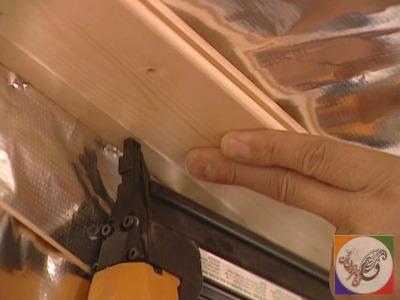
Sauna Modern Home Design
Step 7: Install the Window and Finish the Exterior Walls
It’s easier and faster to cover the interior walls completely and cut out the windows afterward. Use a jig saw or reciprocating saw to cut the window openings (Image 1).
Before finishing the exterior walls, infill the wall cavities with fiberglass insulation, which helps to maintain heat inside the sauna (Image 2).
Install the exterior tongue-and-groove wall boards, following the same process as on the inside, including installing boards over the window openings. As before, cut out the window openings.
Use a jig saw to cut out the junction box openings for the sauna lighting and wall switch. Use the remaining tongue-and-groove boards to clad the overhead soffit (Image 3).
Install the fascia board supplied with the kit.
-
-

Sauna Modern Home Design
Image 1
-

Sauna Modern Home Design
Sauna Modern Home Design
2
-

Sauna Modern Home Design
Image 3
-
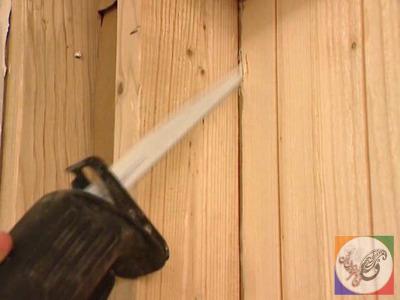
Sauna Modern Home Design
Step 8: Install the Sauna Heater
A unique feature of the heater supplied with this sauna kit is its 18” deep rock chamber, which provides a more consistent and comfortable steam heat than shallow pan heaters (Image 1). When water is added to the hot rocks, steam is created. No drain is needed for the heater because the water boils away completely.
Use a drill/driver and screws to install the two heater support brackets to the wall at the required height (Image 2). The heater is held in place with screws from below.
Rinse the heater rocks before placing them inside the heater. Place the larger rocks in the center and the smaller rocks around them. Maintain some spacing between the rocks for optimum heater performance, faster heat-up time and higher temperatures. Save any extra rocks for replacements.
Attach the heater guards, which prevent accidental heater burns but can be easily removed when necessary.
-
-

Sauna Modern Home Design
Image 1
-

Sauna Modern Home Design
Image 2
-
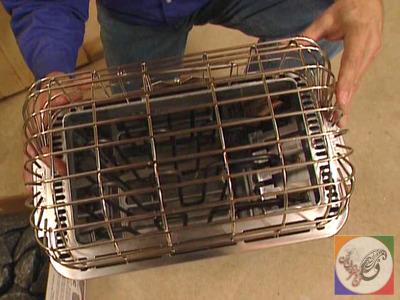
Sauna Modern Home Design
Step 9: Install the Benches, Trim, Windows and Lighting
This kit’s bench rest on supports that allows them to slide in and out for easy cleaning. Measure from the floor and mark a level line on the walls. Fasten the top of the bench supports even with this line (Image 1). Each support is long enough to span at least two wall studs.
Using 3″ screws, install the supports to the wall. Check to make sure they are level. For the “L” shaped top bench, drill through the frame holes with a 3/8″ bit and then bolt the two benches together.
Cut an opening in one wall, as shown in the plans, and install a slide vent (Image 2). The vent is closed when the sauna is heated, then opened during sauna use for fresh air or to regulate the heat.
Set the lower bench across the support brackets, then the upper bench.
Install the H-bracket that supports one end of the side bench. Place the bench on the cross bar and attach it with lag screws from below (Image 3).
Use the pneumatic nailer to install the cove and corner moldings. Some trimming is required for a tight fit. Cut the molding slightly longer (about 1/4”) than the required measurement, then place each end in position and bend or “snap” the molding into place.
Set the windows into place in the wall openings. Use shims and a level to position them, then secure them with screws through the jamb and into the wall framing (Image 4).
Strip lighting was supplied with this sauna kit. Follow the kit instructions and install it along the back wall. The kit also came with a pre-hung glass door. Install it following the instructions provided (Image 5). This kit also supplied small but powerful halogen lights, which are placed above the door.
-
-

Sauna Modern Home Design
Image 1
-

Sauna Modern Home Design
Image 2
-

Sauna Modern Home Design
Image 3
-
-
-

Sauna Modern Home Design
Image 4
-

Sauna Modern Home Design
Image 5
-
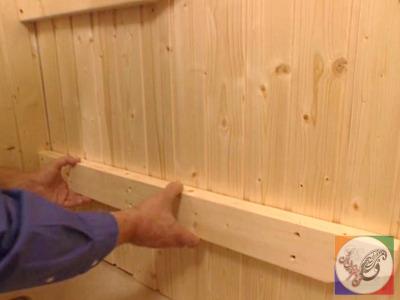
Sauna Modern Home Design
Step 10: Install the Flooring
Flooring is not supplied with the sauna kit, so you’ll want to use something suitable to a barefoot, bathlike environment that also fits with a sauna’s ambience. Duckboards made from 1x2s are natural, easy to make and easily fit to the interior floor shape. Plastic, washable, gridlike interlocking tiles are also available.
Here, the concrete floor was covered with interlocking floor tiles made from recycled car and truck tires. Its puzzle-like pieces lock together and it has a slip-resistant surface with anti-fatigue and sound-absorbing qualities. It can be found at flooring specialty stores.






